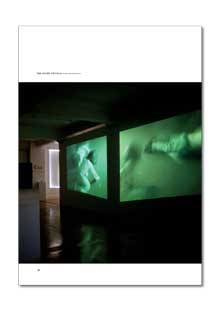 |
|||||||||
|
|
| ...Publications: Annual | ...The Physics Room Annual 2004 | |||||||||||||
|
Cuz. Map, chart, drawing, diagram, atlas, globe… Map - Representation of the earth’s surface or part of it, similar representation of the sky, showing positions of stars or of the moon; diagram showing arrangement or components of things … 1 Mapi, mahere whenua, Panui motuhake mahere, whakaahua, huahuatanga, Pukapuka mahere whenua, ao mahere… It seems all of Natalie Robertson’s works are about mapping. She doesn’t seem to be able to get away from it. In her work Cuz at The Physics Room during Christchurch’s SCAPE - Art & Industry Art Biennial 04, Robertson extended her practice and shifted from the literal to the abstract, from the actual to the intangible, and presented a show highlighting familial and spatial relationships and the mapping of land, time, place and identity, both local and global. Using time-based media - sound and moving image - Robertson, although not visibly present, created a semiautobiographical experience, placing herself at the centre and mapping the space she occupied culturally and physically both within the show and inside her usual art practice. Cuz marked a shift for Robertson, not only in the media she employed (using audio, including “hijacked” and sampled radio sound, and moving image in preference to her customary still photography), but also conceptually. In Cuz Robertson did not work with or refer to cartography, visual representations or markers of land measured, plotted and charted - European definitions of mapping, containing and demarcating land and often history. Instead she worked from margins to centre, from the outside in, and presented landscapes, time and space mapped from a cultural frame of reference through whakapapa, language, dance and song. The measure of mapping is not restricted to the mathematical; it may equally be spiritual, political or moral. By the same token, the mapping’s record is not confined to the archival; it includes the remembered, the imagined, the contemplated. 2 Robertson’s maps in Cuz were abstract and less perceptible than in previous work, such as her well known ‘Prophet’ works and her subsequent waka migration works. In Cuz Robertson mapped the whakapapa relationship between Ngai Tahu and Ngati Porou by recording and sampling radio broadcasts by her two radio DJ cousins, brothers Aubrey and Ron Hughes, from Tahu FM and FM Radio Ngati Porou respectively. Within this framework Robertson also made evident her personal relationship to both the DJs and the two iwi. Weather reports “hijacked” from her cousins’ radio shows (Ron features on a breakfast show and Aubrey on a late night drive show) expressed both the geographical mapping of two distinctive landscapes significant to the project and to Robertson, but also the atmospheric mapping of those two landscapes within opposing timeframes. The large-scale video projections of Player, Breaker ,Dancer, Faker featuring Nathan and Amina Creighton-Kelly - twin six year-olds of Mohawk, Ashinabe, French, South Asian and English descent - break-dancing, highlighted the mapping and claiming of space through movement and placed the twins, through their indigenous status and hip hop art form, in a global and contemporary juncture. Using material gathered in various locations including during her art residency at the Banff Centre, Canada, the video works in Cuz also charted the expanding domain, virtual and cultural, that Robertson is working in. Kati ra e hika featured Kimiora Atkins, a rangatahi and whanaunga of Robertson’s chanting a moeteatea related to the Port Awanui area of East Cape where the artist comes from. The work highlighted the customary Maori practice of mapping and recording connection to landscape through whakapapa and song. The companion piece to Kati ra e hika, a three-minute work called Conversation with Reo, recorded nine year-old Reo Hohaia speaking about the landscape and foreshore of Pungarehu in Taranaki on the west coast of the North Island. With these two final pieces Robertson reinforced the duality and oppositional themes played out throughout the exhibition - Kimiora female, Reo male - and charted the landscape that runs without question from where the artist positions herself, East to West. Megan Tamati-Quennell 1 The New Zealand Pocket Oxford Dictionary, Oxford University Press, 1986 2 Dennis Cosgrove, ‘Human Geographer’, in Mappings, London: Reaktion Books, 1999 View Cuz. Essay by Megan Tamati-Quennell as a PDF This essay originally appeared in The Physics Room Annual 2004 Order your copy today from The Physics Room ! Related 1 - 25 September 2004
|
|||||||||||||


